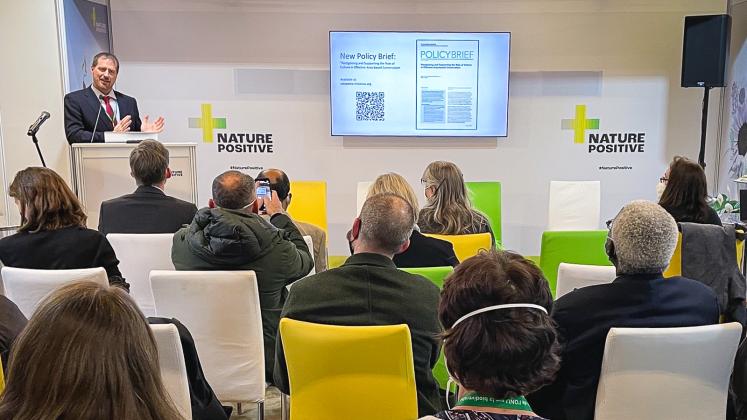As part of the UN Biodiversity Conference (CBD COP15) in Montreal, UNU-IAS co-organised an event on 8 December 2022 focused on Other Effective Area-based Conservation Measures (OECMs). It explored the financial and economic factors affecting the identification, management, and effectiveness of OECMs that include human productive areas. The event advanced discussions on OECMs and socio-ecological production landscapes and seascapes (SEPLS) as part of a project implemented by Conservation International (CI) and UNU-IAS, which had progressed in earlier CBD meetings. Held at the Nature Positive Pavilion, the event was organised in partnership with CI.
Opening the session, William Dunbar (Project Manager, Conservation International) presented a new UNU-IAS policy brief that calls for recognising and supporting the role of culture in creating biodiversity benefits through sustainable human–nature relationships. Drawing on the experiences of SEPLS, it provides recommendations for sustainable land-use management policies that are inclusive, equitable, and incorporate traditional knowledge. Lorena Jaramillo Castros (Economic Affairs Officer, UNCTAD) discussed case studies from the BioTrade Initiative, which promotes sustainable trade and investments and considers local contexts when setting guidelines. Terence Hay-Edie (Programme Advisor, UNDP-GEF Small Grants Programme) highlighted activities of the COMDEKS project, which measures the potential of SEPLS as OECMs as part of the International Partnership for the Satoyama Initiative.
Suneetha Subramanian (Research Fellow, UNU-IAS) moderated a panel discussion on the role of trade and economic incentives in conservation action and enabling sustainable use of resources. Kathy MacKinnon (Chair, IUCN World Commission on Protected Areas) stressed the need to mobilise available options for sustainable finance, such as tax incentives and carbon credits, and integrate them creatively into OECM areas. Justin Mohan (Secretary, National Biodiversity Authority of India) noted that in India areas registered as OECMs would remain under the jurisdiction and care of local institutions, as regulations could discourage communities from seeking OECM classification. Panelists emphasised that creating synergies between ecosystem restoration, local economies, and traditional knowledge of sustainable resource management would incentivise the private sector and local communities to invest in initiatives for biodiversity conservation.



